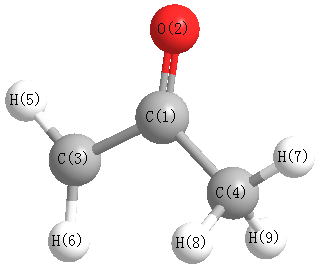Vibrational Frequencies calculated at CCSD(T)/cc-pVDZ
| Mode Number |
Symmetry |
Frequency
(cm-1) |
Scaled Frequency
(cm-1) |
IR Intensities
(km mol-1) |
Raman Act
(Å4/u) |
Dep P |
Dep U |
|---|
| 1 |
A' |
3286 |
3216 |
|
|
|
|
| 2 |
A' |
3174 |
3106 |
|
|
|
|
| 3 |
A' |
3160 |
3093 |
|
|
|
|
| 4 |
A' |
3051 |
2986 |
|
|
|
|
| 5 |
A' |
1647 |
1612 |
|
|
|
|
| 6 |
A' |
1467 |
1436 |
|
|
|
|
| 7 |
A' |
1452 |
1421 |
|
|
|
|
| 8 |
A' |
1386 |
1357 |
|
|
|
|
| 9 |
A' |
1267 |
1240 |
|
|
|
|
| 10 |
A' |
1058 |
1036 |
|
|
|
|
| 11 |
A' |
916 |
897 |
|
|
|
|
| 12 |
A' |
827 |
809 |
|
|
|
|
| 13 |
A' |
518 |
507 |
|
|
|
|
| 14 |
A' |
376 |
368 |
|
|
|
|
| 15 |
A" |
3131 |
3065 |
|
|
|
|
| 16 |
A" |
1470 |
1439 |
|
|
|
|
| 17 |
A" |
1018 |
996 |
|
|
|
|
| 18 |
A" |
691 |
676 |
|
|
|
|
| 19 |
A" |
500 |
490 |
|
|
|
|
| 20 |
A" |
354 |
347 |
|
|
|
|
| 21 |
A" |
94 |
92 |
|
|
|
|
Unscaled Zero Point Vibrational Energy (zpe) 15421.9 cm
-1
Scaled (by 0.9788) Zero Point Vibrational Energy (zpe) 15094.9 cm
-1
See section
III.C.1 List or set vibrational scaling factors
to change the scale factors used here.
See section
III.C.2
Calculate a vibrational scaling factor for a given set of molecules
to determine the least squares best scaling factor.
